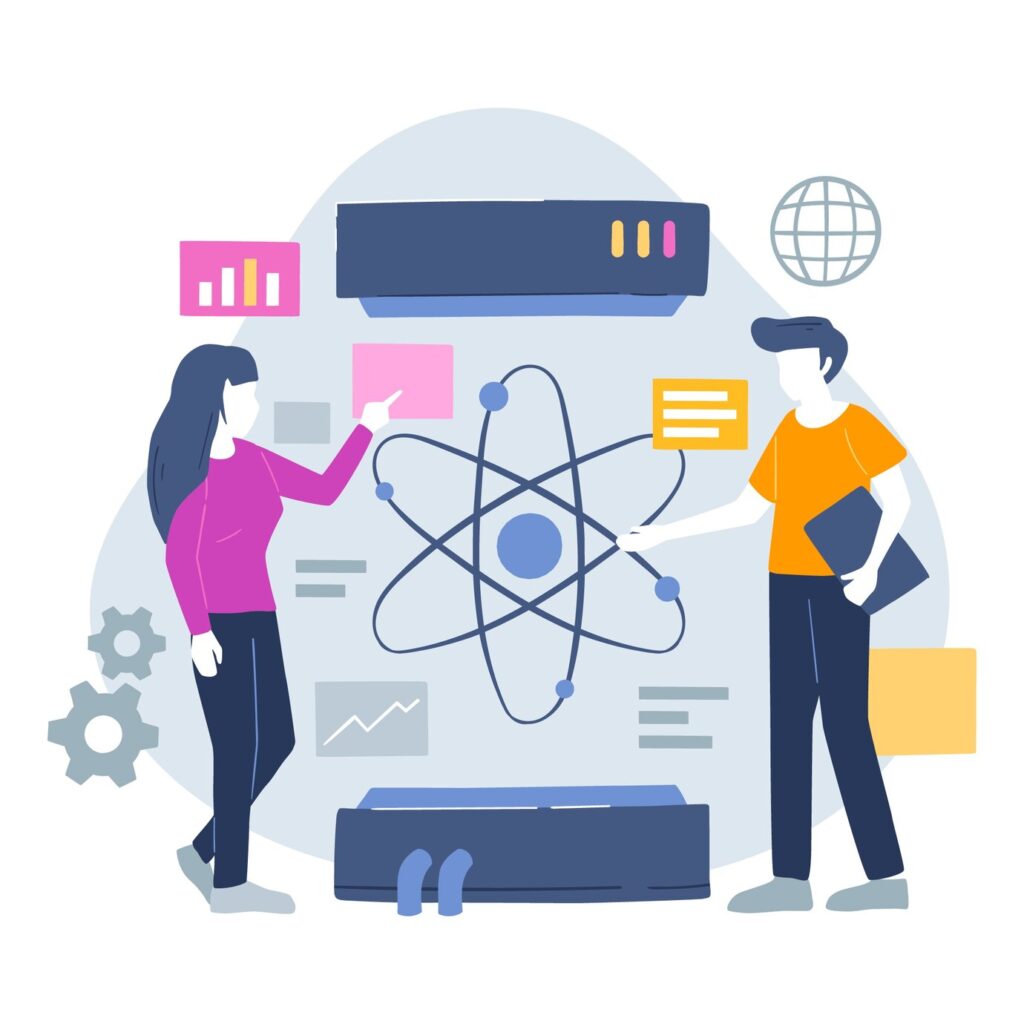The debate between Python and R has long been a pivotal discussion in the data science world. Both languages offer unique strengths, making them indispensable tools for different kinds of data tasks. Choosing the right language can significantly impact your efficiency, the types of projects you excel at, and even your career trajectory.
Python, with its general-purpose nature and ease of learning, has become a go-to for many in machine learning and data science. Meanwhile, R, with its roots in statistics and data visualization, remains a favorite among researchers and analysts working on complex statistical models. In this article, we will explore the key differences between Python and R, comparing their features, performance, and suitability for different types of data science tasks to help you make an informed decision.
What is Python?
Python is a versatile, general-purpose programming language widely used across many industries, including data science. Known for its simplicity and readability, Python’s syntax makes it accessible even to those new to programming. Its rise in popularity in the data science community is due in large part to its extensive library ecosystem. Libraries such as NumPy, Pandas, Matplotlib, and Scikit-learn allow users to perform data manipulation, visualization, and machine learning tasks with ease.
With Python’s widespread use in both academia and industry, its appeal has grown beyond traditional programming. The language has also seen extensive application in machine learning, artificial intelligence, and deep learning thanks to frameworks like TensorFlow and PyTorch. Python’s ability to handle complex computations while maintaining readable and concise code makes it a favorite for large-scale data science projects.
What is R?
R, on the other hand, is a language specifically built for statistical analysis and data visualization. It was designed by statisticians and has a strong focus on statistical modeling, making it a powerful tool for academic research and complex statistical tasks. R’s extensive package ecosystem, especially libraries like ggplot2 for visualization and dplyr for data manipulation, make it a go-to language for those working on intricate statistical analyses and data-driven research.
While R might have a steeper learning curve compared to Python, its specialized nature makes it highly effective for tasks that require heavy statistical computation. Additionally, R has a well-established presence in academia and is widely used in fields like biostatistics, epidemiology, and social sciences, where statistical rigor is critical.
Python vs. R: Head-to-Head Comparison of Key Features
1. Learning Curve
When it comes to learning, Python is known for its easy, beginner-friendly syntax. Its code is clean, intuitive, and simple, making it a popular choice for new programmers. With a large community and plenty of online resources, getting started with Python is often smoother.
R, on the other hand, has a steeper learning curve. It’s built specifically for statistical computing, so without a background in statistics, it can be challenging. However, for those in academia or research, R’s powerful statistical tools and extensive documentation can make the learning investment worthwhile.
2. Data Manipulation and Cleaning
In data wrangling, Python’s Pandas library stands out. It offers powerful tools for cleaning, filtering, and transforming data, making it a go-to for large-scale data manipulation. Pandas’ structure is designed to handle complex tasks with minimal code, allowing users to work efficiently on massive datasets.
R shines in this area as well, with data.table and dplyr being its core libraries for data manipulation. data.table is highly optimized for speed, while dplyr offers a straightforward syntax that makes it easy to chain commands and manipulate data in a readable way. Both libraries are highly efficient, making R equally competitive when it comes to data cleaning.
3. Data Visualization
If you’re looking for flexibility and versatility in visualizations, Python’s Matplotlib and Seaborn are strong options. Matplotlib gives you control over every aspect of your plot, while Seaborn simplifies the process with visually appealing defaults and easy-to-create plots.
However, for those focused on storytelling with data, R’s ggplot2 is often considered superior. It allows you to create complex, publication-quality graphs with a simple, layered approach. Its ability to create aesthetically pleasing, highly customizable plots is one reason why R is often the choice for detailed data visualizations.
4. Statistical Analysis
For pure statistical analysis, R is hard to beat. It was specifically designed for statistical tasks, and its libraries—like lme4 for mixed models and survey for survey data—are extremely powerful and highly specialized. This makes R a top choice for statisticians, researchers, and analysts working with complex datasets.
Python is growing in this area, with tools like Statsmodels and SciPy offering a wide range of statistical functions. While Python might not have the same depth in traditional statistics, its versatility and integration with machine learning libraries make it a solid option for projects that require both statistics and predictive modeling.
5. Machine Learning and AI
When it comes to machine learning and artificial intelligence, Python is the dominant player. With powerful libraries like Scikit-learn, TensorFlow, and Keras, Python offers end-to-end solutions for building and deploying models. From basic machine learning tasks to advanced neural networks, Python’s extensive ecosystem makes it the first choice for many data scientists and engineers.
R, while not as widely adopted in machine learning, has been catching up with packages like caret and mlr. These tools provide access to a range of machine learning algorithms, but Python’s broader adoption and flexibility give it a distinct edge, especially for production-level machine learning.
6. Community and Ecosystem
Python boasts a vast and diverse community that spans industries such as technology, finance, healthcare, and academia. Its broad usage means there are constant updates, a rich selection of packages, and plenty of support through forums, tutorials, and documentation.
R’s community, while smaller, is highly focused and deeply embedded in academic and research circles. This makes R an excellent choice for those in statistics-heavy fields, where rigorous analysis and cutting-edge research are the priorities.
Python vs. R: Performance and Scalability for Data Science
Speed and Efficiency
- Python:
- Typically faster for tasks that require heavy computing power.
- Uses libraries like NumPy and Pandas, which are built for speed.
- Best suited for projects like machine learning and deep learning, where performance matters.
- R:
- While not as fast as Python in general use, it excels at statistical tasks.
- data.table helps speed up data manipulation, making R more efficient for specific jobs.
- Ideal for projects focused on detailed statistical analysis.
Handling Big Data
- Python:
- Works smoothly with big data tools like Apache Spark and Dask.
- Can scale easily across many machines, making it perfect for distributed data processing.
- A popular choice for industries handling large datasets and using cloud technologies.
- R:
- Has gained big data capabilities with packages like sparklyr and bigmemory.
- Now able to handle large datasets and link with big data platforms like Spark.
- While it can manage big data, Python still has an advantage when it comes to scaling across distributed systems.
IDEs and Tools: Enhancing Your Python and R Workflow
Python IDEs
- Jupyter Notebooks:
- Ideal for data science and machine learning.
- Allows you to write code, visualize data, and document all in one place.
- Excellent for sharing work and collaborating with others.
- PyCharm:
- Full-featured IDE with powerful debugging and refactoring tools.
- Great for larger Python projects, offering many extensions for data science workflows.
- VS Code:
- Lightweight but highly customizable with extensions.
- Supports Python and offers good integration with Jupyter for interactive coding.
R IDEs
- RStudio:
- The go-to IDE for R, offering a clean and intuitive interface.
- Supports data visualization, statistical analysis, and document generation.
- Highly popular in both academic and professional environments.
- R Tools for Visual Studio:
- Integrates R with Microsoft’s Visual Studio.
- Useful for those familiar with Visual Studio who want to combine R into their workflow.
Collaborative Tools
- GitHub & GitLab:
- Both platforms support version control, enabling team collaboration on data science projects.
- They allow you to track changes in code and facilitate teamwork by hosting projects online.
- R Markdown & Jupyter Notebooks:
- R Markdown is perfect for generating reproducible reports and documentation in R.
- Jupyter Notebooks let Python users blend code with documentation, making it easier to share analyses.
Choosing the Right Language: Python Vs R
1. Consider Your Background and Goals
Your background can significantly influence whether Python or R is the better fit for you. If you have prior programming experience, especially with general-purpose languages, Python may feel more intuitive. Python’s straightforward, clean syntax and versatility make it a great choice for tasks like data manipulation, machine learning, and even web development.
On the other hand, if you come from a statistical or academic research background, R might align better with your skillset. R was built by statisticians for statisticians, so it naturally excels in statistical modeling and data visualization. It’s especially popular in fields like epidemiology, social sciences, and research, where complex data analysis is essential. If your focus is on research or visualizing data, R could be your ideal tool.
2. Industry and Job Market Trends
When it comes to job opportunities, Python is hard to beat. Python’s presence in tech companies and startups is overwhelming, largely because of its flexibility. It’s used not only for data science but also for machine learning, artificial intelligence, automation, and even web development. As industries increasingly rely on automation and big data, Python’s demand in the job market continues to grow, making it a smart career choice.
That said, R holds a strong position in specialized fields. Academia, healthcare, and industries focused on statistical analysis, like pharmaceuticals, still prioritize R for its robust statistical capabilities. While there may be fewer R-focused roles compared to Python, R remains a critical tool in these specialized industries where in-depth statistical knowledge is key.
3. Personal Preferences
Your personal coding style is another important factor. If you prefer clear, readable code, Python’s simple syntax will likely appeal to you. Python is known for its ease of learning, making it accessible to beginners and professionals alike. Its readability also allows for faster development and easier debugging, which is why many developers favor it.
R, on the other hand, may seem more complex if you’re unfamiliar with its statistical focus. While it can be less intuitive for general-purpose programming, R is highly rewarding for statisticians and researchers who need powerful data analysis tools. If you enjoy diving deep into statistical models and working in a research-driven environment, R’s specialized syntax and capabilities can provide exactly what you need.
Python and R in Action: Real-World Case Studies
Python in Action
Python’s flexibility makes it a go-to language for a wide range of real-world data science applications. For example, Python is often used in web scraping to collect massive datasets from websites. Libraries like BeautifulSoup and Scrapy allow data scientists to extract and analyze web data quickly, which is especially valuable for market research and competitive analysis.
Another common use of Python is in building and deploying machine learning models. Python’s libraries, such as Scikit-learn, TensorFlow, and Keras, provide a full stack for everything from basic machine learning algorithms to complex deep learning systems. These models can be trained, optimized, and then deployed into production environments, making Python an ideal choice for projects that require scalability.
Python also shines in data analysis within web applications. Frameworks like Flask and Django make it possible to integrate data science models directly into web applications, enabling real-time data processing and user interaction. This is particularly valuable in sectors like finance and e-commerce, where data-driven decision-making is essential.
R in the Spotlight
R, with its strong statistical capabilities, excels in areas that demand complex data analysis and visualization. In complex statistical modeling, R’s specialized packages, such as lme4 for linear mixed models and glmnet for regularization, are widely used in academic research and industries like healthcare and economics. These tools make R the preferred choice for tasks that require detailed statistical analyses.
R is also renowned for its ability to create publication-quality visualizations. Packages like ggplot2 allow users to generate highly customizable, aesthetically pleasing graphs that can communicate insights effectively. This makes R indispensable in fields where data storytelling and presentation are key, such as in academic publishing or high-level business reports.
Lastly, R’s capabilities in data exploration and experimentation are particularly useful for statisticians and researchers. With a rich ecosystem of packages designed for statistical testing, hypothesis generation, and exploratory data analysis, R enables users to gain deep insights into their data and test new ideas rapidly.
Beyond the Basics: Advanced Considerations
Integrating Python and R
For data scientists who want to leverage both Python and R, integration is not only possible but also highly beneficial. Tools like RPy2 (or rpy2) allow you to run R code directly within Python scripts, enabling you to harness the strengths of both languages in a single workflow. This can be particularly useful in projects where Python’s machine learning capabilities and R’s statistical expertise can complement each other.
- Use Case: You might use Python to build a machine learning model and then turn to R for more in-depth statistical analysis of the results.
- Best Practices: When integrating both languages, ensure that workflows are well-documented and that reproducibility is maintained. Version control with tools like Git can also help keep track of changes across both languages.
This blend of Python and R allows data scientists to combine flexibility with statistical rigor, offering a powerful toolkit for complex projects.
Emerging Trends and Future Outlook
Both Python and R continue to grow and evolve, with each language playing a pivotal role in shaping the future of data science. However, they are carving out different niches based on their strengths.
- Python is expected to maintain its dominance in AI and deep learning, with continued integration into cutting-edge frameworks like TensorFlow and PyTorch. As more industries adopt AI-driven applications, Python’s role in driving innovation will expand even further.
- R, on the other hand, will continue to thrive in statistical analysis and specialized fields like Bayesian statistics, causal inference, and experimental design. While Python covers a broader range of industries, R remains indispensable for deep, complex statistical research and data visualization, particularly with packages like ggplot2 that allow for publication-quality visualizations.
Looking ahead, Python’s broader industry adoption positions it as the future leader in data science innovation, particularly in automation and AI. However, R’s focus on statistical precision and academic research ensures its relevance for highly specialized tasks.
FAQs: Addressing Common Questions
1. Which language is easier to learn?
Python is generally easier to learn due to its simple, readable syntax, while R has a steeper learning curve, especially for those without a statistics background.
2. Which language is more popular?
Python is more widely used across industries, especially in tech and data science, while R is highly valued in academia and fields that focus on statistical analysis.
3. Can I use Python and R together?
Yes, you can integrate both languages using tools like RPy2 or reticulate, allowing you to combine Python’s versatility with R’s statistical strengths in a single workflow.
Conclusion
Both Python and R have unique strengths that make them valuable tools for data science, depending on your needs and background. Python is ideal if you are looking for a versatile language that excels in machine learning, artificial intelligence, and large-scale applications. Its readable syntax and wide range of libraries make it accessible and powerful for diverse projects.
R, on the other hand, remains the go-to language for statisticians and researchers who require specialized tools for statistical analysis and data visualization. Its strong presence in academia and research fields ensures its continued relevance, particularly for those working with complex datasets and needing advanced visualizations.
Ultimately, the choice between Python and R comes down to your specific goals. The best way to find the right fit is to experiment with both, discover what aligns with your workflow, and apply it to the tasks at hand. Whether you choose Python, R, or both, each has the potential to significantly enhance your data science capabilities.


